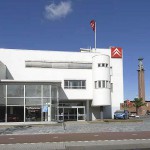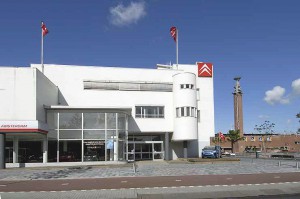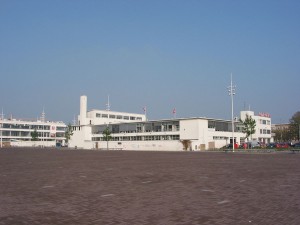
(English below)
Leider wird neben dem Kölner noch ein weiterer historisch bedeutender Citroën-Standort in Europa aufgegeben: “Stadionplein Amsterdam”, das zwischen 1930-1931 nach Entwürfen des holländischen Architekten Jan Wils im Zusammenhang mit dem nahegelegenen olympischen Stadion Amsterdam (1928) entstanden ist. Wils war ein Bewunderer des amerikanischen Frank Lloyd Wright, dessen Einfluss an diesem Gebäude unverkennbar ist.
Wils, der als Mitbegründer der “Nieuwe Haagse School” gilt, wurde 1929 von der N.V. Citroën Automobiles, wie das Unternehmen damals noch hieß, beauftragt, ein neues zentrales Gebäude zu entwerfen. Der ehemalige Hauptsitz lag zuvor in der Weteringschans in Amsterdam, doch statt der weit im Stadtgebiet verstreuten Räumlichkeiten nun sollten Büros, Verkaufsräume und Werkstatt zusammengeführt werden.
Am Stadtrand entstand in unmittelbarer Nähe des Stadions der neue Bau, und auch die Amsterdamer Stadtregierung, die anfänglich Skepsis zeigt, daß ein kommerzieller Neubau nicht mit dem Stadion harmonieren würde, war vom neuen Gebäude angetan.
Wils soll anfänglich erst kein Interesse gezeigt haben, eine kommerzielle Auftragsarbeit anzunehmen, aber die ihm gewährte künstlerische Freiheit und ein großzügiges Honorar sollen ihn dann umgestimmt haben…
Das Design wurde im Jahr 1930 vollendet wird und bot einen Showroom, einen “schnellen Service” für ad-hoc Reparaturen und Büros im Erdgeschoss und einen umfangreiche Reparaturwerkstatt auf der ersten Etage, die durch eine schräge Auffahrt erreichbar war.
Wils suchte bei seinem Entwurf eine ausgewogene Wechselwirkung zwischen dem neuen Gebäude und dem Olympiastadion. Das Betonskelett des Gebäudes erlaubt mit großen Fenstern viel Licht im Innenraum und zeigt zugleich viel Flexibilität in seiner Architektur und harmoniert damit gut zum benachbarten Stadion. Das Gebäude war zunächst in einem gelben Ockerton gehalten, während es heutzutage weiß gestrichen ist. In den 70er Jahren wurde das Gebäude renoviert.
Neben den Unterhaltskosten für Gebäude und Infrastruktur sind insbesondere Parkprobleme, Zufahrt und die Modernisierung des Showrooms für die beiden Marken Citroën und DS die Hauptgründe für den Umzug in ein der Autobahn A10 nahegelegenes neues Gebäude. Der Umzug soll zum Jahresende stattfinden.
—–
Citroën Netherlands moves to a new site
Unfortunately, another historically significant Citroën site in Europe is abandoned – that famous “Stadionplein Amsterdam” building was created between 1930-1931, designed by the Dutch architect Jan Wils in connection with the nearby Olympic Stadium Amsterdam (1928). Wils was an admirer of the American Frank Lloyd Wright, whose influence on this building is unmistakable.
Wils, who is regarded as the founders of the “Nieuwe Haagse School”, was commissioned in 1929 by NV Citroën Automobiles, as the company was then known, to design a new central building. The former headquarters was previously in the Weteringschans in Amsterdam, but instead of the widely scattered premises within the city limits now offices, showrooms and workshop should be merged.
In the suburbs originated in the immediate vicinity of the stadium, the new construction should be placed , and also the Amsterdam city government, which shows initially skeptical that a commercial building would not harmonize with the stadium, was impressed by the new architecture.
Wils said to have shown no interest initially only to accept a commercial contract work, but granted him artistic freedom and a generous fee to have then retuned him to execute this works…
The design was is completed in 1930 and offered a showroom, a “quick service” for ad-hoc repairs and offices on the ground floor and a large repair shop on the first floor which was reached by a sloping driveway.
Wils was looking at his draft to find a balanced interaction between the new building and the Olympic Stadium. The concrete skeleton of the building with large windows allowing plenty of light in the interior and at the same time shows much flexibility in its architecture and harmonizes so well with the adjacent stadium. The building was initially held in a yellow ocher, while it is now painted white. In the 70s, the building was renovated.
In addition to the maintenance costs of the buildings and infrastructure in particular parking problems, road access and modernization of the showroom for the two brands “Citroën” and “DS” and are the main reasons for moving to a highway A10 nearby new building. The move will take place at the end of 2014.

